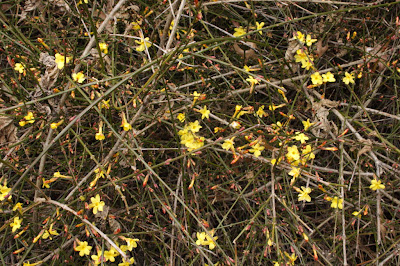I was absentmindedly looking out into the garden about a half hour ago and noticed something brown moving around. At first I thought it might be a small deer, but then an immediately recognizable face came into view: it was an adult red fox. It was sitting out in the sun grooming itself and scratching now and then. Every once in a while its eyes would start to close, as if the warmth from the sun might be inducing a nap. But it remained alert, continually turning its head this way and that.
This was probably the first time I've seen a fox seemingly at east in broad daylight. Usually I see them as a fleeting blur of color at the edge of the woods or fields.
When we first moved here a bit over fifty years ago, I saw a gray fox once. And there were local skunks back then, too. I have not seen a local skunk for decades. Opossums are still here, but they seem to be either very uncommon or very secretive - and more likely to be seen dead on the road than live in the woods. Groundhogs seem not to remain in the immediate area for long, but do occasionally pass through. Raccoons are a common sight. Foxes, always red foxes, I see infrequently, but often enough to suggest that the local population is healthy and here to stay. They can occasionally be seen prowling the road side at night down in the park.
This was probably the first time I've seen a fox seemingly at east in broad daylight. Usually I see them as a fleeting blur of color at the edge of the woods or fields.
When we first moved here a bit over fifty years ago, I saw a gray fox once. And there were local skunks back then, too. I have not seen a local skunk for decades. Opossums are still here, but they seem to be either very uncommon or very secretive - and more likely to be seen dead on the road than live in the woods. Groundhogs seem not to remain in the immediate area for long, but do occasionally pass through. Raccoons are a common sight. Foxes, always red foxes, I see infrequently, but often enough to suggest that the local population is healthy and here to stay. They can occasionally be seen prowling the road side at night down in the park.








